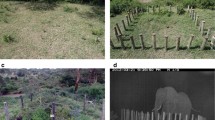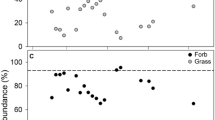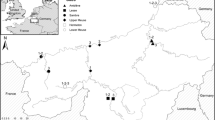Abstract
Invasions by non-native taxa can have severe consequences for native species. In the heavily invaded serpentine grasslands of central California, many native species appear to be restricted to isolated outcrops of shallow serpentine soil, or “hummocks,” although the extent to which these hummocks function as refuges for native vegetation has never been quantified. We tested whether native plant species were restricted to hummocks within a serpentine grassland at the University of California Sedgwick Reserve near Santa Barbara, California by sampling species along hummock-grassland gradients. We also examined the influence of soil parameters, hummock area, proximity to other hummocks, and spatial location on species composition across 16 hummocks at this site. Both the hummocks and the surrounding grassland had high Mg, low Ca, and low Ca to Mg ratios typical of serpentine systems. Hummocks appeared to be more stressful environments because of their shallower soils, lower cation exchange capacity, and greater percent sand. Of the 27 most common plant species sampled along hummock-grassland transects, we identified 8 hummock specialists, 7 edge specialists, 8 matrix specialists, and 4 generalists. Importantly, both the hummock and matrix specialist groups included native species. Plant community composition was correlated with spatial positioning of the hummocks and with soil Ca, Na, K, and N. The number of species increased and community composition changed with increasing hummock area. Species composition was most similar among hummocks in close proximity to each other, and decreased with increasing distance between hummocks. Our results suggest that the community structure of serpentine grasslands is spatially complex and an effective management or restoration plan must address this complexity.
Similar content being viewed by others
References
Adams T.E., Vaughn C.E. and Sands P.B. 1999. Geographic races may exist among perennial grasses. California Agriculture 53: 33–38.
Armstrong J.K. and Huenneke L.F. 1992. Spatial and temporal variation in species composition in California grasslands: the interaction of drought and substratum. In: Baker A.J.M., Proctor J. and Reeves R.D. (Eds.), The vegetation of ultramafic (serpentine) soils. Intercept Ltd., Andover, England, pp. 213–233.
Baker H.G. 1978. Invasion and replacement in Californian and neotropical grasslands. In: Wilson J.R. (Ed.), Plant relations in pastures. CSIRO, East Melbourne, pp. 368–384.
Brooks R.R. 1987. Serpentine and its vegetation. In: Dudley T.R. (Ed.), Ecology, Phytogeography and Physiology Series. Dioscorides Press, Portland, Oregon.
D'Antonio C.M. and Vitousek P.M. 1992. Biological invasions by exotic grasses, the grass/fire cycle, and global change. Annual Review of Ecology and Systematics 23: 63–87.
Drake J.A., Mooney H.A., di Castri F., Groves R.H., Kruger F.J., Regmanák M. and Williamson M. (Eds.), 1989. Biological invasions: a global perspective. Wiley, Chichester, England.
Galatowitsch S.M. and van der Valk A.G. 1996. The vegetation of restored and natural prairie wetlands. Ecological Applications 6: 102–112.
Harrison S. 1997. How natural habitat patchiness affects the distribution of diversity in Californian serpentine chaparral. Ecology 78: 1898–1906.
Harrison S. 1999a. Local and regional diversity in a patchy landscape: native, alien, and endemic herbs on serpentine. Ecology 80: 70–80.
Harrison S. 1999b. Native and alien species diversity at the local and regional scales in a grazed California grassland. Oecologia 121: 99–106.
Hatch D.A., Bartolome J.W., Fehmi J.S. and Hillyard D.S. 1999. Effects of burning and grazing on a coastal California Grassland. Restoration Ecology 7: 376–381.
Heady H.F. 1956a. Changes in California annual plant community induced by manipulation of natural mulch. Ecology 37: 781–798.
Heady H.F. 1956b. Evaluation and measurement of the California annual type. Journal of Range Management 9: 25–27.
Heady H.F. 1958. Vegetational changes in the California annual type. Ecology 39: 402–415.
Heady H.F. 1977. Valley grassland. In: Barbour M.G. and Major J. (Eds.), Terrestrial vegetation of California. Wiley, New York, pp. 491–514.
Hickman S. 1997. The Jepson manual: higher plants of California. University of California Press, Berkeley.
Hobbs R.J. and Hobbs V.J. 1987. Gophers and grassland a model of vegetation response to patchy soil disturbance. Vegetatio 69: 141–146.
Hobbs R.J. and Humphries S.E. 1995. An integrated approach to the ecology and management of plant invasions. Conservation Biology 9: 761–770.
Hobbs R.J. and Mooney H.A. 1985. Community and population dynamics of serpentine grassland annuals in relation to gopher disturbance. Oecologia (Berlin) 67: 342–351.
Hobbs R.J. and Mooney H.A. 1991. Effects of rainfall variability and gopher disturbance on serpentine annual grassland dynamics. Ecology 72: 59–68.
Hobbs R.J. and Mooney H.A. 1995. Spatial and temporal variability in California annual grassland: Results from a long-term study. Journal of Vegetation Science 6: 43–56.
Huenneke L.F., Hamburg S.P., Koide R., Mooney H.A. and Vitousek P.M. 1990. Effects of soil resources on plant invasion and community structure in Californian serpentine grassland. Ecology 71: 478–491.
Jackson L.E. 1985. Ecological origins of California's Mediterranean grasses. Journal of Biogeography 12: 349–361.
Kruckeberg A.K. 1984. California serpentines: flora, vegetation, geology, soils and management problems. University of California Press, Berkeley.
Lobo A., Moloney K., Chic O. and Chiariello N. 1998. Analysis of fine-scale spatial pattern of a grassland from remotely-sensed imagery and field collected data. Landscape Ecology 13: 111–131.
MacArthur R.H. and Wilson E.O. 1967. The theory of island biogeography. Princeton University Press, Princeton, New Jersey.
Manly B.F.J. 1986. Randomization and regression methods for testing for associations with geographical, environmental and biological distances between populations. Researches in Population Ecology 28: 201–218.
Mantel N. 1967. The detection of disease clustering and a generalized regression approach. Cancer Research 27: 209–220.
McCullagh P. and Nelder J.A. 1989. Generalized Linear Models. Chapman and Hall, New York.
McNaughton S.J. 1968. Structure and function of California grasslands. Ecology 49: 962–972.
Menke J.W. 1992. Grazing and fire management for native perennial grass restoration in California grasslands. Fremontia 20: 22–25.
Meyer M. and Schiffman P. 1999. Fire season and mulch reduction in a California grassland: comparison of restoration strategies. Madroño 46: 25–37.
Moloney K.A. and Levin S.A. 1996. The effects of disturbance architecture on landscape-level population dynamics. Ecology 77: 375–394.
Mooney H.A. and Drake J.A. (Eds.), 1986. Ecology of biological invasions of North America and Hawaii. Springer-Verlag, New York.
Mooney H.A., Hamburg S.P. and Drake J.A. 1986. The invasions of plants and animals into California. In: Mooney H.A. and Drake J.A. (Eds.), Ecology of biological invasions of North America and Hawaii. Springer-Verlag, New York, pp. 250–272.
Murphy D.D. and Ehrlich P.R. 1989. Conservation biology of California's remnant grasslands. In: Huenneke L.F. and Mooney H. (Eds.), Grassland structure and function: California annual grassland. Kluwer Academic Publishers, Dordrecht, pp. 201–211.
Neter J., Wasseman W. and Kutner M.H. 1985. Applied Linear Statistical Models. Richard D. Irwin, Inc., Homewood, Illinois.
Parma A.M., Amarasekare P., Mangel M., Moore J., Murdoch W.W., Noonburg E., Pascual M.A., Possingham H.P., Shea K., Wilcox C. and Yu D. 1999. What can adaptive management do for our fish, forests, food and biodiversity? Integrative Biology 1: 16–26.
Pitt M.D. and Heady H.F. 1978. Responses of annual vegetation to temperature and rainfall patterns in Northern California. Ecology 59: 336–350.
Pollak O. and Kan T. 1998. The use of prescribed fire to control invasive exotic weeds at Jepson Prairie Preserve. In: Witham C.W., Bauder E.T.D., Belk Ferren Jr. W.R. and Ornduff R. (Eds.), Ecology, conservation, and management of vernal pool ecosystems. Proceedings of a 1996 conference. California Native Plant Society, Sacramento, pp. 241–249.
Proctor J. 1971. The plant ecology of serpentine. II. Plant response to serpentine soils. Journal of Ecology 59: 397–410.
Proctor J. and Woodell S.R.J. 1975. The ecology of serpentine soils. Advances in Ecological Research 9: 255–366.
Seabloom E.W., Borer E.T., Boucher V.L., Burton R.S., Cottingham K.L., Goldwasser L., Gram W.K., Kendall B.E. and Micheli F. in press. Competition, seed limitation, disturbance, and reestablishment of California native annual forbs. Ecological Applications.
Shea K., Amarasekare P., Mangel M., Moore J., Murdoch W.W., Noonburg E., Parma A., Pascual M.A., Possingham H.P., Wilcox C. and Yu. D. 1998. Management of populations in conservation, harvesting and control. Trends in Ecology & Evolution 13: 371–375.
Shoulders C.L. 1994. Methods of restoring Nassella pulchra (purple needlegrass) at Jepson Prairie Preserve, Solano County, CA. Thesis. University of Wisconsin, Madison.
Vitousek P.M., D'Antonio C.M., Loope L.L., Rejmanek M. and Westbrooks R. 1997. Introduced species: a significant component of human-caused global change. New Zealand Journal of Ecology 21: 1–16.
Walker R.B. 1954. Factors affecting plant growth on serpentine soils. Ecology 35: 259–266.
Walters C.J. 1986. Adaptive management of renewable resources. Macmillan, New York.
Author information
Authors and Affiliations
Corresponding author
Rights and permissions
About this article
Cite this article
Gram, W.K., Borer, E.T., Cottingham, K.L. et al. Distribution of plants in a California serpentine grassland: are rocky hummocks spatial refuges for native species?. Plant Ecology 172, 159–171 (2004). https://doi.org/10.1023/B:VEGE.0000026332.57007.7b
Issue Date:
DOI: https://doi.org/10.1023/B:VEGE.0000026332.57007.7b




